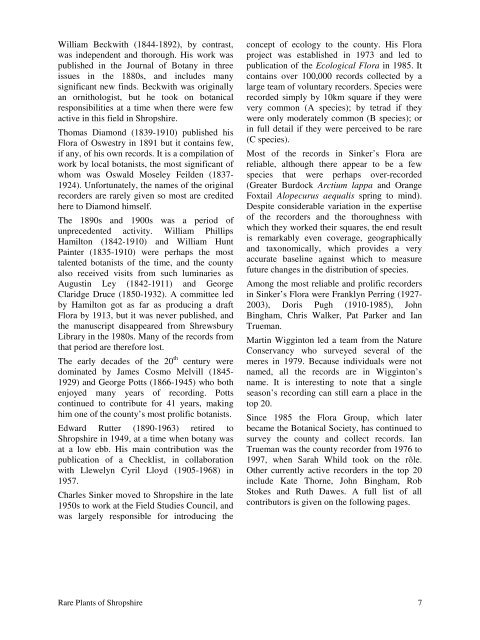Shropshire - Botanical Society of the British Isles
Shropshire - Botanical Society of the British Isles
Shropshire - Botanical Society of the British Isles
- No tags were found...
Create successful ePaper yourself
Turn your PDF publications into a flip-book with our unique Google optimized e-Paper software.
William Beckwith (1844-1892), by contrast,was independent and thorough. His work waspublished in <strong>the</strong> Journal <strong>of</strong> Botany in threeissues in <strong>the</strong> 1880s, and includes manysignificant new finds. Beckwith was originallyan ornithologist, but he took on botanicalresponsibilities at a time when <strong>the</strong>re were fewactive in this field in <strong>Shropshire</strong>.Thomas Diamond (1839-1910) published hisFlora <strong>of</strong> Oswestry in 1891 but it contains few,if any, <strong>of</strong> his own records. It is a compilation <strong>of</strong>work by local botanists, <strong>the</strong> most significant <strong>of</strong>whom was Oswald Moseley Feilden (1837-1924). Unfortunately, <strong>the</strong> names <strong>of</strong> <strong>the</strong> originalrecorders are rarely given so most are creditedhere to Diamond himself.The 1890s and 1900s was a period <strong>of</strong>unprecedented activity. William PhillipsHamilton (1842-1910) and William HuntPainter (1835-1910) were perhaps <strong>the</strong> mosttalented botanists <strong>of</strong> <strong>the</strong> time, and <strong>the</strong> countyalso received visits from such luminaries asAugustin Ley (1842-1911) and GeorgeClaridge Druce (1850-1932). A committee ledby Hamilton got as far as producing a draftFlora by 1913, but it was never published, and<strong>the</strong> manuscript disappeared from ShrewsburyLibrary in <strong>the</strong> 1980s. Many <strong>of</strong> <strong>the</strong> records fromthat period are <strong>the</strong>refore lost.The early decades <strong>of</strong> <strong>the</strong> 20 th century weredominated by James Cosmo Melvill (1845-1929) and George Potts (1866-1945) who bo<strong>the</strong>njoyed many years <strong>of</strong> recording. Pottscontinued to contribute for 41 years, makinghim one <strong>of</strong> <strong>the</strong> county’s most prolific botanists.Edward Rutter (1890-1963) retired to<strong>Shropshire</strong> in 1949, at a time when botany wasat a low ebb. His main contribution was <strong>the</strong>publication <strong>of</strong> a Checklist, in collaborationwith Llewelyn Cyril Lloyd (1905-1968) in1957.Charles Sinker moved to <strong>Shropshire</strong> in <strong>the</strong> late1950s to work at <strong>the</strong> Field Studies Council, andwas largely responsible for introducing <strong>the</strong>concept <strong>of</strong> ecology to <strong>the</strong> county. His Floraproject was established in 1973 and led topublication <strong>of</strong> <strong>the</strong> Ecological Flora in 1985. Itcontains over 100,000 records collected by alarge team <strong>of</strong> voluntary recorders. Species wererecorded simply by 10km square if <strong>the</strong>y werevery common (A species); by tetrad if <strong>the</strong>ywere only moderately common (B species); orin full detail if <strong>the</strong>y were perceived to be rare(C species).Most <strong>of</strong> <strong>the</strong> records in Sinker’s Flora arereliable, although <strong>the</strong>re appear to be a fewspecies that were perhaps over-recorded(Greater Burdock Arctium lappa and OrangeFoxtail Alopecurus aequalis spring to mind).Despite considerable variation in <strong>the</strong> expertise<strong>of</strong> <strong>the</strong> recorders and <strong>the</strong> thoroughness withwhich <strong>the</strong>y worked <strong>the</strong>ir squares, <strong>the</strong> end resultis remarkably even coverage, geographicallyand taxonomically, which provides a veryaccurate baseline against which to measurefuture changes in <strong>the</strong> distribution <strong>of</strong> species.Among <strong>the</strong> most reliable and prolific recordersin Sinker’s Flora were Franklyn Perring (1927-2003), Doris Pugh (1910-1985), JohnBingham, Chris Walker, Pat Parker and IanTrueman.Martin Wigginton led a team from <strong>the</strong> NatureConservancy who surveyed several <strong>of</strong> <strong>the</strong>meres in 1979. Because individuals were notnamed, all <strong>the</strong> records are in Wigginton’sname. It is interesting to note that a singleseason’s recording can still earn a place in <strong>the</strong>top 20.Since 1985 <strong>the</strong> Flora Group, which laterbecame <strong>the</strong> <strong>Botanical</strong> <strong>Society</strong>, has continued tosurvey <strong>the</strong> county and collect records. IanTrueman was <strong>the</strong> county recorder from 1976 to1997, when Sarah Whild took on <strong>the</strong> rôle.O<strong>the</strong>r currently active recorders in <strong>the</strong> top 20include Kate Thorne, John Bingham, RobStokes and Ruth Dawes. A full list <strong>of</strong> allcontributors is given on <strong>the</strong> following pages.Rare Plants <strong>of</strong> <strong>Shropshire</strong> 7
















